Coconut crab (33 photos)
 Bashny.Net
Bashny.Net
Seeing this amazing animal, just a nervous shudder with horror and surprise - in fact there is no one in the world more interesting and, at the same time, worse than the coconut crab. In any case, among the arthropods - he is considered to be the largest of their representative.

have coconut crab there are many other "names" for example, crab or coconut crab a thief - it's a strange animal indeed steal their prey. The travelers of the past centuries, who visited the islands, which lie in the West Pacific and the Indian Ocean, they say that the coconut crab hidden from prying eyes in the thick foliage of palm trees to then suddenly grab their prey, lying directly under a tree or near from him.
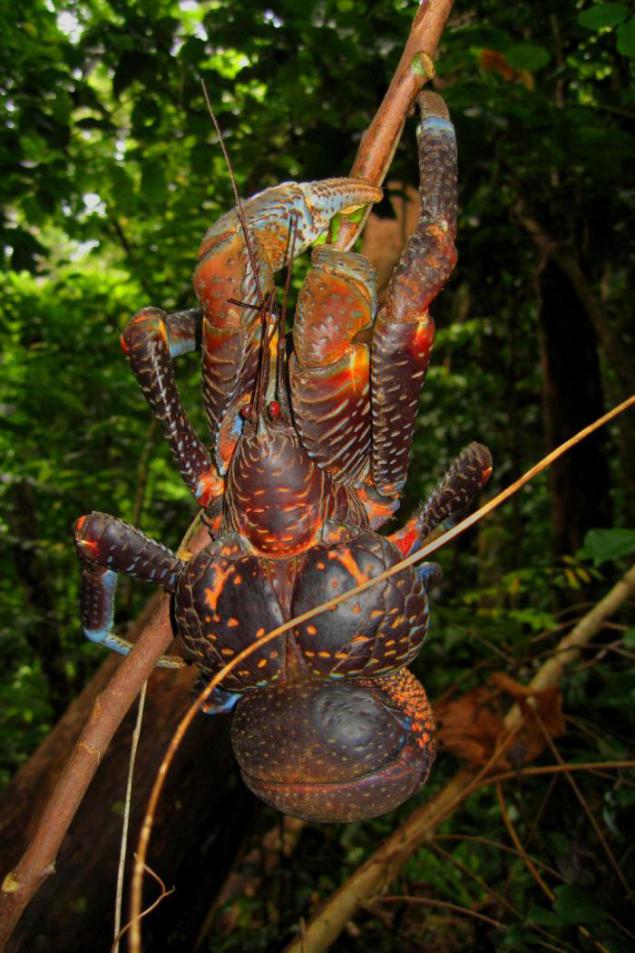
Coconut crab (lat. Birgus latro) actually crab is not at all in spite of the striking similarity in title to said arthropod relative. This is the land hermit crab belonging mean decapod.
Strictly speaking, called palm thief land animals can also be a stretch, as part of his life takes place in the marine element, and even light appear tiny crustaceans in the water column. Newborn babies with vulnerable soft abdomen busily crawling on the bottom of the pond in search of a reliable house, which can serve as a nutshell, and deserted clamshell.
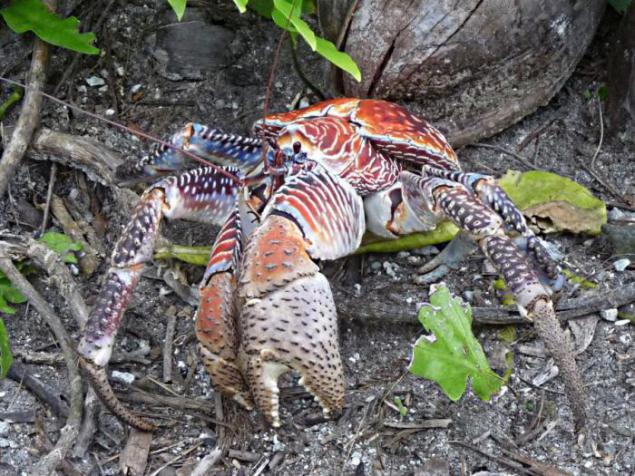
In "Childhood» birgus latro not too different from a hermit crab: he drags behind him his shell and almost all his time in the water. But coming from one larval state and leaving the water, he is no longer able to return, and at some point and wearing of a shell-house. Unlike bryushek hermit crabs his belly is not the Achilles heel and gradually hardens, and the tail curls up under the body, protecting the body from cuts. Thanks to a special light, he begins to breathe out of water.
In truth, most of the legends of his marked precisely this feature - the first Europeans arrived on the island, described as the coconut crabs hiding in the trees with a bushy claws creature that suddenly stretched to the ground and captured prey, up to sheep and goats. Scientists have confirmed that birgus latro has great strength and can lift up to 30 kg weight. However, they found that their ability to use the crab to be dragged from place to place the goods, preferring to feed on dead animals, crabs and fallen fruit.

Due to what cancers manage to exist and equally comfortable in the water and on land? It turns out that the wise nature has provided them with two tools of breathing: light, ventilation air at the surface and gills that allow breathing underwater. That's only the second time with the body loses its function and palm pilferers have to completely switch to terrestrial life.

Those who wish to meet such a miracle would have to go to the tropics - coconut crabs are found on the islands of the Indian Ocean and in some western Pacific islands. To see them in the daylight challenging palm thieves are nocturnal, and solar time hiding in rock crevices or burrows in the sand lined with coconut fiber - it helps maintain the desired humidity level in the home.

And though the version that their front claws cancer is able to split a coconut, he failed miserably, his limbs, however, sufficiently developed to quickly climb up the trunk of a palm tree or a human bite phalanges. And by coconuts cancer really indifferent: nourishing flesh - the main dish in its menu, which he owes his "coconut" name.

Sometimes diet enriched with fruits pandanov cancers, according to some sources, the palm and the thieves might eat their own kind. Starving cancer unerringly finds the closest "restaurant": internal navigation is a great sense of smell, which is and outputs it to a food source, even if it is for many kilometers.

As for the "thieves 'status' of cancer, but this is guilty of his uncontrollable desire to pull into its burrow sundries from the category of that which is bad - and not very edible.
Coconut crab meat, not only is among the delicacies, but also applies to aphrodisiacs, so these arthropods are actively hunting. To prevent their extinction, some countries set strict limits on the catch coconut crabs.
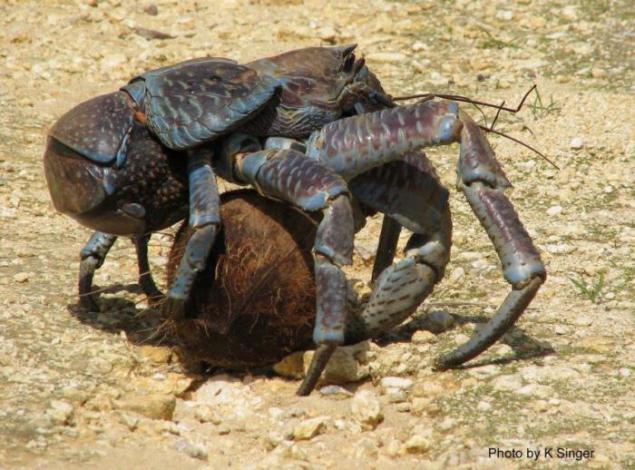
The body of the coconut crab, like all decapods, divided into a front part (cephalothorax), which has 10 legs and abdomen. Front, the largest pair of legs has large claws (claws), and left claw is much larger than the right. The next two pairs, like other hermits, great, powerful with sharp ends, coconut crabs are used for travel on vertical or inclined surfaces. The fourth pair of legs is much less than the first three, which allows young coconut crabs to settle in mollusk shells or coconut shells, carry protection. The adults use this pair for walking and climbing. Last, very little steam, which is usually hidden inside the shell is used for the care of female eggs and male - mating.

Except for the larval stage, coconut crabs can not swim, and they will certainly drown if will stay in the water for over an hour. For breathing they use a special organ called gill lungs. This organ can be interpreted as a developmental stage between gills and lungs, and is one of the most significant adaptations of the coconut crab habitat. Gill lungs contain tissue similar to that found in gills, but suited to the absorption of oxygen from the air and not from the water.
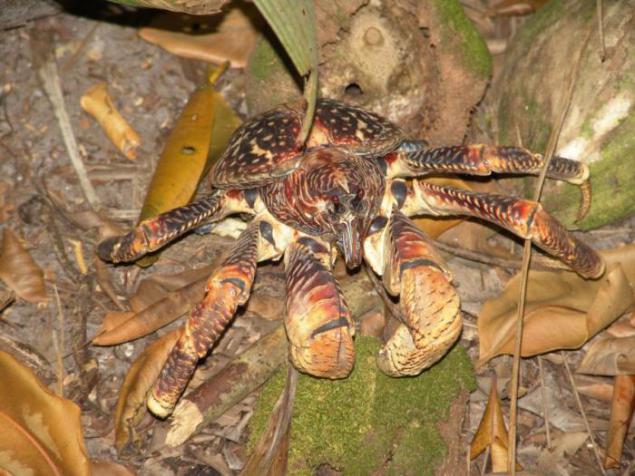
Coconut crab has a well-developed sense of smell, which he uses to find food. Like most crabs live in the water, they have specialized organs located on the antennae, which determine the concentration and direction of the odor.
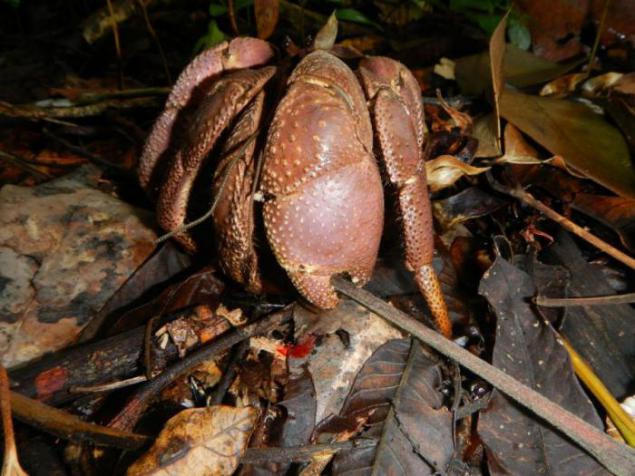
During the day, these arthropods holed up in burrows or rock crevices that line of coconut fiber or foliage that would increase the humidity in the home. During holidays in his burrow, the coconut crab closes the entrance of one claw to maintain a humid microclimate in the hole, which is necessary for its respiratory organs.

As its name suggests, this crab eats coconuts, and actually be able to climb the coconut trees to a height of 6 meters, where powerful claws pinch off coconuts, if they are not yet available on the ground. If a fallen coconut does not break if dropped, the crab for a week or even two will be his gut until you get to the juicy pulp of the nut. If this bothers crab dreary job of work, he raises a coconut up a tree and throws it down in order to facilitate their work. Going back to the ground, they sometimes fall, but without damage to health may suffer a drop of 4 to 5 meters. Do not give up the coconut crab and other fruits, newborn turtles and fell. They also were seen for catching and eating a Polynesian rats.
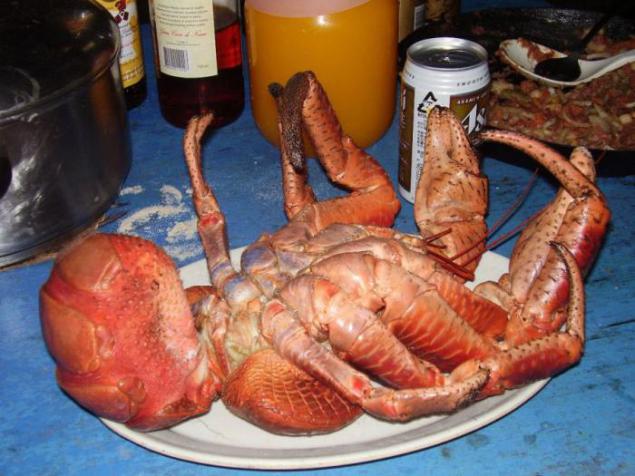
Other its name - coconut crab, he has received for love of all brilliant. If the path will fall crab spoon, fork, or other shiny object, rest assured, he will certainly try to drag him to his burrow.

Since the beginning of June to the end of August palm thieves during the breeding season begins. Courtship process is long and tedious, but the pairing itself quite quickly. The fertilized egg is the female for several months on the lower side of the abdomen. When the eggs are ready for hatching, the female goes down to the sea shore at high tide and releases larvae into the water. Over the next three - four weeks floating in the water, the larvae go through several stages of development. After 25 - 30 days, had little crab sink to the bottom, settling in shells of gastropods, and are preparing to migrate to the ground. At this time, the kids are sometimes visited by land, and gradually lose the ability to breathe underwater, eventually moving to the main habitat. Coconut crabs reach sexual maturity in about five years after hatching, but reach their maximum size only to 40 years.

Palm thieves live in the tropics, on the islands of the Indian and western Pacific Oceans. Christmas Island in the Indian Ocean has the highest population density of the coconut crab in the world.
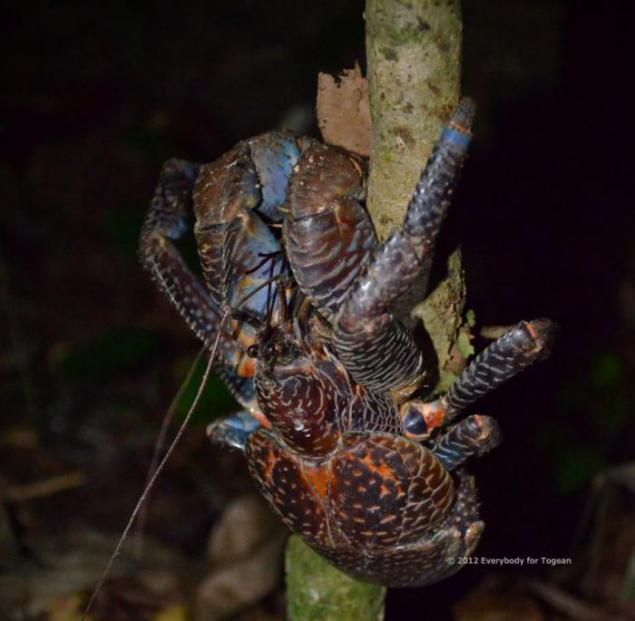
Swedish and Australian scientists have confirmed the veracity of the stories about the coconut crabs. For Pacific Islanders claimed that those few kilometers can be smelled, such as meat or ripe fruit. Indeed, the special bait planted by investigators, immediately attracted the attention of thieves crabs, which nevertheless disdained the usual slices of bread that are susceptible common crabs.
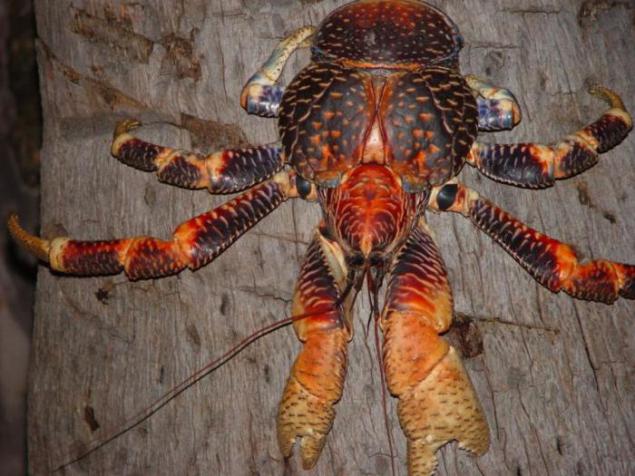
Wiper function is, of course, nice and helpful, however, as being predominantly birgus latro night and not very friendly, he stumbled on, locals do not feel much enthusiasm. Reducing their numbers has forced the local authorities to set a limit on the catch birgus latro. In Papua New Guinea may not include it in the restaurant menus, on the island of Saipan - catch crabs with a carapace less than 3, 5 cm, and from June to September, during the breeding season.

On the inner wall surface of the gill cavity of a descendant of the land hermit crabs acinar develop folds of skin, which branch out numerous blood vessels. This is - the real lungs, allowing oxygen to use gill cavity filling the air. Lungs are ventilated through skafognatita movements, and also due to the ability of the animals from time to time to lift and lower the carapace, which are special muscles.
It is remarkable that at the same time preserved and gills, though relatively small size. Remove the gills does not harm the breath; On the other hand, cancer is completely lost the ability to breathe in water. Immersed in the water coconut crab died after 4 hours. Residual gills, apparently, do not function. Coconut crab digs a shallow hole in the soil, which is lined with coconut fiber. Charles Darwin said that the natives on some islands are selected from palm thief nor the fiber they need in their nemudrenyh economy. Sometimes coconut crab content natural shelters - crevices in the rocks, in cavities drained coral reefs, but also in such cases to use their plate plant material maintained at a house increased humidity.


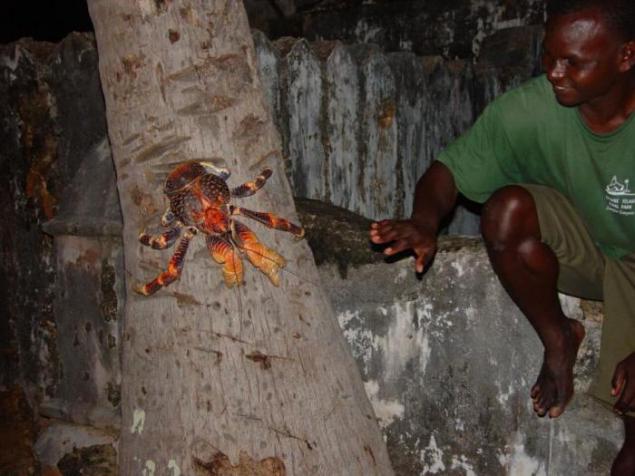
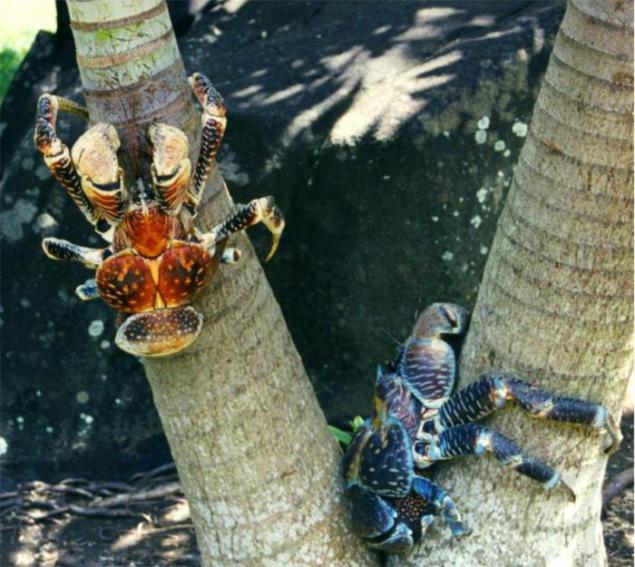
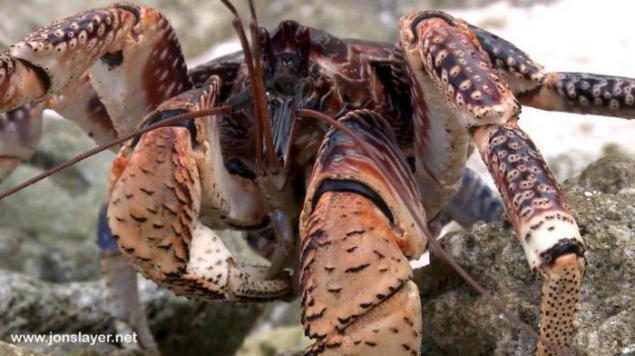
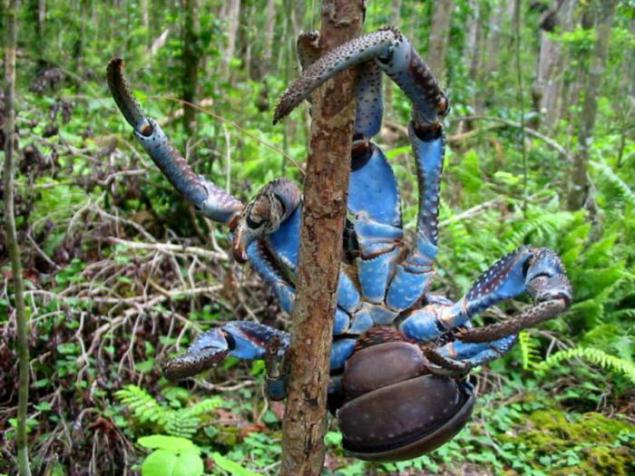
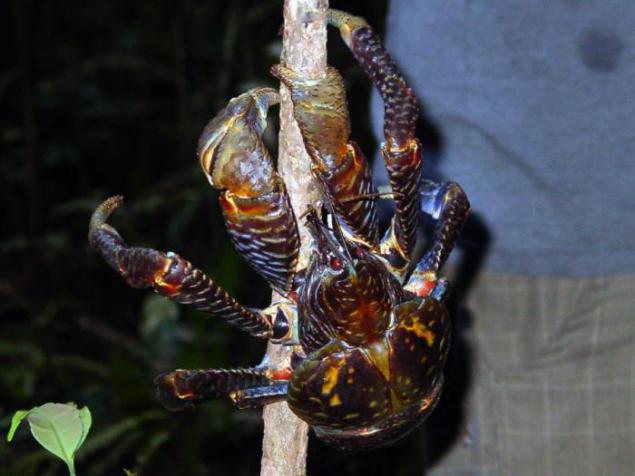
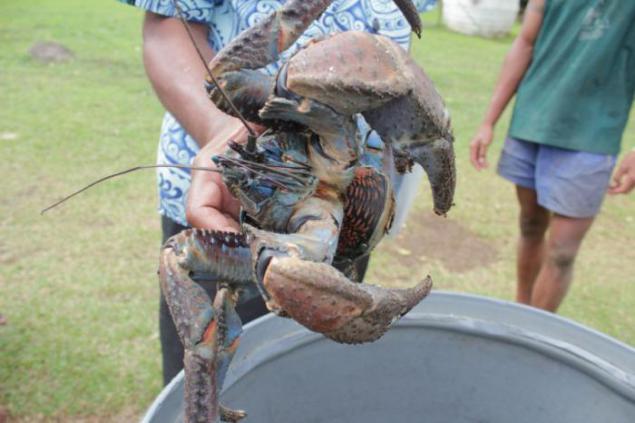



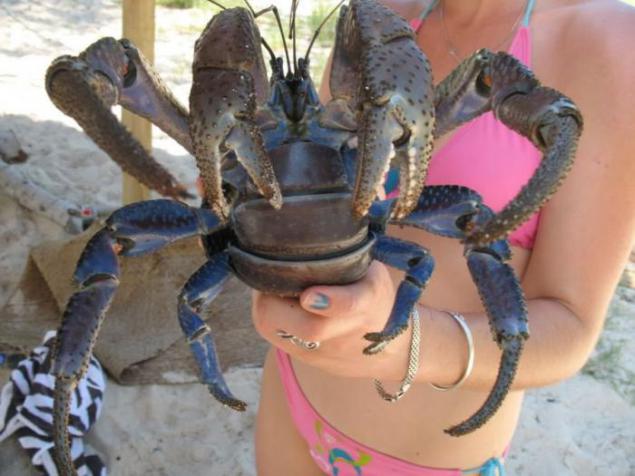
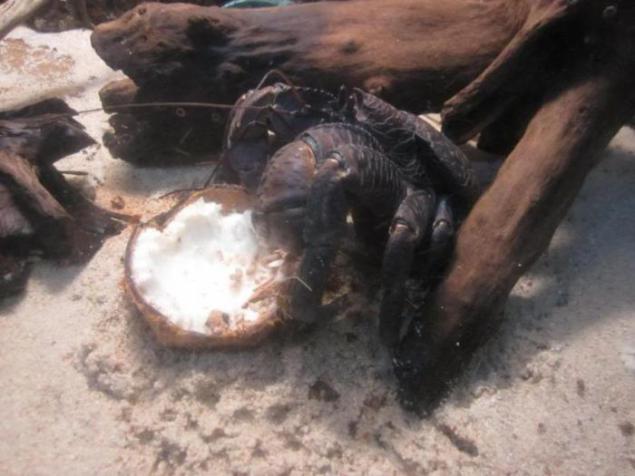
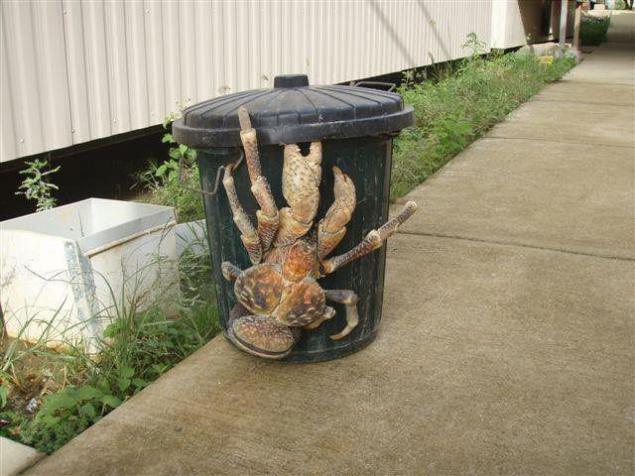

have coconut crab there are many other "names" for example, crab or coconut crab a thief - it's a strange animal indeed steal their prey. The travelers of the past centuries, who visited the islands, which lie in the West Pacific and the Indian Ocean, they say that the coconut crab hidden from prying eyes in the thick foliage of palm trees to then suddenly grab their prey, lying directly under a tree or near from him.

Coconut crab (lat. Birgus latro) actually crab is not at all in spite of the striking similarity in title to said arthropod relative. This is the land hermit crab belonging mean decapod.
Strictly speaking, called palm thief land animals can also be a stretch, as part of his life takes place in the marine element, and even light appear tiny crustaceans in the water column. Newborn babies with vulnerable soft abdomen busily crawling on the bottom of the pond in search of a reliable house, which can serve as a nutshell, and deserted clamshell.

In "Childhood» birgus latro not too different from a hermit crab: he drags behind him his shell and almost all his time in the water. But coming from one larval state and leaving the water, he is no longer able to return, and at some point and wearing of a shell-house. Unlike bryushek hermit crabs his belly is not the Achilles heel and gradually hardens, and the tail curls up under the body, protecting the body from cuts. Thanks to a special light, he begins to breathe out of water.
In truth, most of the legends of his marked precisely this feature - the first Europeans arrived on the island, described as the coconut crabs hiding in the trees with a bushy claws creature that suddenly stretched to the ground and captured prey, up to sheep and goats. Scientists have confirmed that birgus latro has great strength and can lift up to 30 kg weight. However, they found that their ability to use the crab to be dragged from place to place the goods, preferring to feed on dead animals, crabs and fallen fruit.

Due to what cancers manage to exist and equally comfortable in the water and on land? It turns out that the wise nature has provided them with two tools of breathing: light, ventilation air at the surface and gills that allow breathing underwater. That's only the second time with the body loses its function and palm pilferers have to completely switch to terrestrial life.

Those who wish to meet such a miracle would have to go to the tropics - coconut crabs are found on the islands of the Indian Ocean and in some western Pacific islands. To see them in the daylight challenging palm thieves are nocturnal, and solar time hiding in rock crevices or burrows in the sand lined with coconut fiber - it helps maintain the desired humidity level in the home.

And though the version that their front claws cancer is able to split a coconut, he failed miserably, his limbs, however, sufficiently developed to quickly climb up the trunk of a palm tree or a human bite phalanges. And by coconuts cancer really indifferent: nourishing flesh - the main dish in its menu, which he owes his "coconut" name.

Sometimes diet enriched with fruits pandanov cancers, according to some sources, the palm and the thieves might eat their own kind. Starving cancer unerringly finds the closest "restaurant": internal navigation is a great sense of smell, which is and outputs it to a food source, even if it is for many kilometers.

As for the "thieves 'status' of cancer, but this is guilty of his uncontrollable desire to pull into its burrow sundries from the category of that which is bad - and not very edible.
Coconut crab meat, not only is among the delicacies, but also applies to aphrodisiacs, so these arthropods are actively hunting. To prevent their extinction, some countries set strict limits on the catch coconut crabs.

The body of the coconut crab, like all decapods, divided into a front part (cephalothorax), which has 10 legs and abdomen. Front, the largest pair of legs has large claws (claws), and left claw is much larger than the right. The next two pairs, like other hermits, great, powerful with sharp ends, coconut crabs are used for travel on vertical or inclined surfaces. The fourth pair of legs is much less than the first three, which allows young coconut crabs to settle in mollusk shells or coconut shells, carry protection. The adults use this pair for walking and climbing. Last, very little steam, which is usually hidden inside the shell is used for the care of female eggs and male - mating.

Except for the larval stage, coconut crabs can not swim, and they will certainly drown if will stay in the water for over an hour. For breathing they use a special organ called gill lungs. This organ can be interpreted as a developmental stage between gills and lungs, and is one of the most significant adaptations of the coconut crab habitat. Gill lungs contain tissue similar to that found in gills, but suited to the absorption of oxygen from the air and not from the water.

Coconut crab has a well-developed sense of smell, which he uses to find food. Like most crabs live in the water, they have specialized organs located on the antennae, which determine the concentration and direction of the odor.

During the day, these arthropods holed up in burrows or rock crevices that line of coconut fiber or foliage that would increase the humidity in the home. During holidays in his burrow, the coconut crab closes the entrance of one claw to maintain a humid microclimate in the hole, which is necessary for its respiratory organs.

As its name suggests, this crab eats coconuts, and actually be able to climb the coconut trees to a height of 6 meters, where powerful claws pinch off coconuts, if they are not yet available on the ground. If a fallen coconut does not break if dropped, the crab for a week or even two will be his gut until you get to the juicy pulp of the nut. If this bothers crab dreary job of work, he raises a coconut up a tree and throws it down in order to facilitate their work. Going back to the ground, they sometimes fall, but without damage to health may suffer a drop of 4 to 5 meters. Do not give up the coconut crab and other fruits, newborn turtles and fell. They also were seen for catching and eating a Polynesian rats.

Other its name - coconut crab, he has received for love of all brilliant. If the path will fall crab spoon, fork, or other shiny object, rest assured, he will certainly try to drag him to his burrow.

Since the beginning of June to the end of August palm thieves during the breeding season begins. Courtship process is long and tedious, but the pairing itself quite quickly. The fertilized egg is the female for several months on the lower side of the abdomen. When the eggs are ready for hatching, the female goes down to the sea shore at high tide and releases larvae into the water. Over the next three - four weeks floating in the water, the larvae go through several stages of development. After 25 - 30 days, had little crab sink to the bottom, settling in shells of gastropods, and are preparing to migrate to the ground. At this time, the kids are sometimes visited by land, and gradually lose the ability to breathe underwater, eventually moving to the main habitat. Coconut crabs reach sexual maturity in about five years after hatching, but reach their maximum size only to 40 years.

Palm thieves live in the tropics, on the islands of the Indian and western Pacific Oceans. Christmas Island in the Indian Ocean has the highest population density of the coconut crab in the world.

Swedish and Australian scientists have confirmed the veracity of the stories about the coconut crabs. For Pacific Islanders claimed that those few kilometers can be smelled, such as meat or ripe fruit. Indeed, the special bait planted by investigators, immediately attracted the attention of thieves crabs, which nevertheless disdained the usual slices of bread that are susceptible common crabs.

Wiper function is, of course, nice and helpful, however, as being predominantly birgus latro night and not very friendly, he stumbled on, locals do not feel much enthusiasm. Reducing their numbers has forced the local authorities to set a limit on the catch birgus latro. In Papua New Guinea may not include it in the restaurant menus, on the island of Saipan - catch crabs with a carapace less than 3, 5 cm, and from June to September, during the breeding season.

On the inner wall surface of the gill cavity of a descendant of the land hermit crabs acinar develop folds of skin, which branch out numerous blood vessels. This is - the real lungs, allowing oxygen to use gill cavity filling the air. Lungs are ventilated through skafognatita movements, and also due to the ability of the animals from time to time to lift and lower the carapace, which are special muscles.
It is remarkable that at the same time preserved and gills, though relatively small size. Remove the gills does not harm the breath; On the other hand, cancer is completely lost the ability to breathe in water. Immersed in the water coconut crab died after 4 hours. Residual gills, apparently, do not function. Coconut crab digs a shallow hole in the soil, which is lined with coconut fiber. Charles Darwin said that the natives on some islands are selected from palm thief nor the fiber they need in their nemudrenyh economy. Sometimes coconut crab content natural shelters - crevices in the rocks, in cavities drained coral reefs, but also in such cases to use their plate plant material maintained at a house increased humidity.














Tags
See also
10 most amazing animal hybrids
Religious series
22 modern cult TV series
Google invited users to write a will
The UK was one of the world's largest convention of fans of tattoos
Perfume for workaholic: smells affect performance, memory and concentration
Unusual moments in the life of animals
Strange and rare animals
Strange and rare animals (31 photos)
Amazing places on Earth that need to see with your own eyes
















